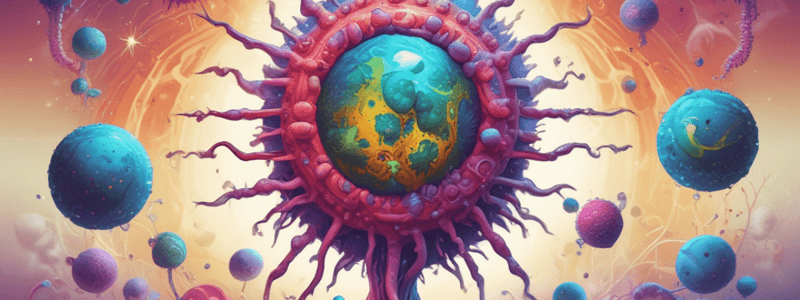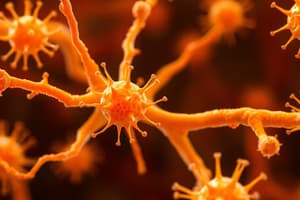Podcast
Questions and Answers
Why is it crucial to regulate inflammation to a specific site?
Why is it crucial to regulate inflammation to a specific site?
- To reduce the synthesis of acute-phase proteins in the liver.
- To prevent systemic inflammation, which is always beneficial.
- To avoid uncontrolled systemic inflammation, which is problematic. (correct)
- To stimulate the hypothalamus and induce fever.
What is the result of inflammation in the hypothalamus?
What is the result of inflammation in the hypothalamus?
- Increased synthesis of acute-phase proteins in the liver.
- Vasodilation and increased vascular permeability.
- Increased white cell production in the bone marrow.
- Fever, anorexia, sleepiness, and depression. (correct)
What happens when cell activation occurs during inflammation?
What happens when cell activation occurs during inflammation?
- Reduced synthesis of acute-phase proteins in the liver.
- Release of pro-inflammatory chemokines, lipid mediators, and cytokines. (correct)
- Inhibition of mast cell activation.
- Downregulation of antimicrobial defenses.
What is the role of mast cells in inflammation?
What is the role of mast cells in inflammation?
What is the purpose of chemokines in inflammation?
What is the purpose of chemokines in inflammation?
What happens when there is no pathogen presence for inflammation?
What happens when there is no pathogen presence for inflammation?
What is the result of increased binding of pathogens to PAMPs and DAMPS?
What is the result of increased binding of pathogens to PAMPs and DAMPS?
What is the effect of chemokines on neutrophil migration?
What is the effect of chemokines on neutrophil migration?
What is the primary purpose of phagocytosis in relation to reactive oxygen species and reactive nitrogen species?
What is the primary purpose of phagocytosis in relation to reactive oxygen species and reactive nitrogen species?
Which of the following is NOT a function of lysozyme?
Which of the following is NOT a function of lysozyme?
What is the primary activation mechanism of the alternative pathway of the complement system?
What is the primary activation mechanism of the alternative pathway of the complement system?
Which of the following is NOT a characteristic of the lectin pathway of the complement system?
Which of the following is NOT a characteristic of the lectin pathway of the complement system?
What is the primary function of lactoferrin?
What is the primary function of lactoferrin?
Which of the following statements is TRUE about the classical pathway of the complement system?
Which of the following statements is TRUE about the classical pathway of the complement system?
What is the primary function of PRRs in innate immunity?
What is the primary function of PRRs in innate immunity?
Which of the following is NOT a characteristic of PAMPs?
Which of the following is NOT a characteristic of PAMPs?
What is the role of DAMPs in innate immunity?
What is the role of DAMPs in innate immunity?
Which of the following are examples of Sentinel Cells?
Which of the following are examples of Sentinel Cells?
What is the response of sentinel cells to PAMPs and DAMPs?
What is the response of sentinel cells to PAMPs and DAMPs?
What is the primary function of phagocytosis in the context of inflammation?
What is the primary function of phagocytosis in the context of inflammation?
What is the result of the respiratory burst in phagocytosis?
What is the result of the respiratory burst in phagocytosis?
Which type of cells are predominant in the blood during the later stages of inflammation?
Which type of cells are predominant in the blood during the later stages of inflammation?
What is the role of processing in phagocytosis?
What is the role of processing in phagocytosis?
How do NK cells recognize potential pathogens or unhealthy cells?
How do NK cells recognize potential pathogens or unhealthy cells?
Which of the following terms has this function: it breaches the cell membrane of microbes, allowing water to rush into the cell, and causes destruction by osmotic lysis?
Which of the following terms has this function: it breaches the cell membrane of microbes, allowing water to rush into the cell, and causes destruction by osmotic lysis?
Flashcards are hidden until you start studying
Study Notes
Innate Immunity: Pathogen Recognition
- PAMPs (pathogen-associated molecular patterns) are components shared among different pathogens, differing from self, and are only found in microbes.
- PAMPs play a crucial role in recognizing pathogens.
- DAMPs (damage-associated molecular patterns) are released when cells die or are generated when connective tissue is damaged.
- DAMPs recognize damage to one's own cells.
Pattern Recognition Receptors (PRRs)
- PRRs are receptors of innate immunity that recognize PAMPs and DAMPs.
- PRRs can be soluble or membrane-bound.
- They are found in various areas of the body (intracellular or membrane-bound).
- PRRs can be phagocytic or play a signaling role.
- Signaling PRRs trigger cytokine production and granule release.
- Phagocytic PRRs are located on the cell surface.
Sentinel Cells
- Sentinel cells are cells with high quantities of PRRs, allowing for better surveillance of PAMPs and DAMPs.
- Sentinel cells are majorly involved in immune surveillance and threat recognition.
- Examples of sentinel cells include dendritic cells, macrophages, and mast cells.
- These cells recognize PAMPs and DAMPs, activate pro-inflammatory and antimicrobial mediators, and produce histamine, cytokines, and prostaglandins.
Innate Immunity: Inflammation
- Inflammation occurs when sentinel cells are exposed to PAMPs, DAMPs, or pro-inflammatory cytokines.
- Inflammation needs to be strictly regulated to a specific site, rather than becoming systemic.
- Uncontrolled systemic inflammation is problematic.
- Inflammation can lead to various symptoms, such as fever, anorexia, sleepiness, and depression, depending on the affected site.
Mast Cells and Chemokines
- Mast cells release histamine and serotonin, causing vasodilation and increased vascular permeability, allowing neutrophils to migrate towards microbes.
- Chemokines are a type of cytokine that guides and directs leukocyte migration towards pathogens.
- Chemokines bind to neutrophil receptors, altering the cytoskeleton, and propelling neutrophils towards the microbe.
Inflammation: Leukocyte Kinetics
- Step 1: Neutrophils predominate during acute inflammation, using phagocytosis to kill pathogens.
- Step 2: Monocytes/macrophages predominate at the later stages of inflammation.
- Step 3: Lymphocytes are present once the adaptive immune system is engaged in the response.
Innate Immunity: Phagocytosis
- Phagocytosis is an active process of capturing and ingesting foreign objects/microbes by phagocytes, such as neutrophils and macrophages.
- Phagocytosis involves the destruction of microorganisms, damaged cells, and cellular debris, and foreign objects.
- Phagocytosis induces cytokine production and processing and presentation of antigens.
Phagocytosis: Steps
- Step 1: The phagocyte detects and binds to its target.
- Step 2: It surrounds the captured object with pseudopodia and engulfs the object via endocytosis.
- Step 3: The endocytosed object becomes enclosed in the phagosome.
- Step 4: The phagosome fuses with the lysosome to form a phagolysosome.
- Step 5: The contents of the lysosome are released into the phagolysosome.
Phagocytosis: Intracellular Killing Mechanisms
- Phagocytosis utilizes an oxidative pathway, involving the respiratory burst, and reactive oxygen and nitrogen species.
- Phagocytosis also utilizes a non-oxidative pathway, dependent on the actions of toxic substances present in lysosomes.
- Cationic proteins, lysozyme, lactoferrin, and proteolytic and hydrolytic enzymes are involved in the killing of bacteria.
Innate Immunity: Complement System
- The complement system is a collection of circulating and membrane-associated proteins, activated in a sequential manner.
- Many complement proteins are proteolytic enzymes.
- There are three possible activation pathways: Alternative, Classical, and Lectin pathways.
- All activation pathways have the same outcome, but differ in their initiation.
- The alternative and lectin pathways are part of the innate immune response, while the classical pathway is involved in the adaptive immune response.
Studying That Suits You
Use AI to generate personalized quizzes and flashcards to suit your learning preferences.




